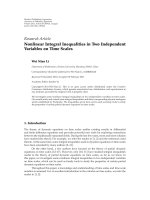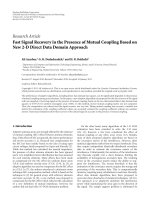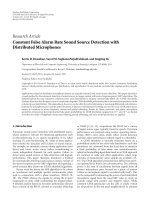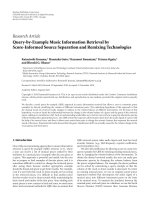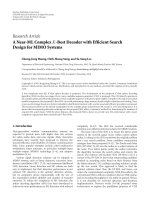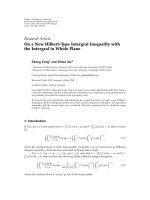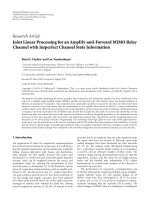Báo cáo hóa học: " Research Article Wireless Information-Theoretic Security in an Outdoor Topology with Obstacles: Theoretical Analysis and Experimental Measurements" docx
Bạn đang xem bản rút gọn của tài liệu. Xem và tải ngay bản đầy đủ của tài liệu tại đây (3.73 MB, 7 trang )
Hindawi Publishing Corporation
EURASIP Journal on Wireless Communications and Networking
Volume 2011, Article ID 628747, 7 pages
doi:10.1155/2011/628747
Research Article
Wireless Information-Theoretic Security in
an Outdoor Topology with Obstacles: Theoretical Analysis
and Experimental Measurements
Theofilos Chrysikos,
1
Tasos Dagiuklas,
2
and Stavros Kotsopoulos
1
1
Department of Electrical and Computer Engineering, University of Patras, 26500 Rio Patras, Greece
2
Department of Telecommunication Systems and Networks, TEI of Messolonghi, 30300 Nafpaktos, Greece
Correspondence should be addressed to Theofilos Chrysikos,
Received 15 June 2010; Accepted 20 August 2010
Academic Editor: Christos Verikoukis
Copyright © 2011 Theofilos Chrysikos et al. This is an open access article distributed under the Creative Commons Attribution
License, which permits unrestricted use, distribution, and reproduction in any medium, provided the original work is properly
cited.
This paper presents a Wireless Information-Theoretic Security (WITS) scheme, which has been recently introduced as a robust
physical layer-based security solution, especially for infrastructureless networks. An autonomic network of moving users was
implemented via 802.11n nodes of an ad hoc network for an outdoor topology with obstacles. Obstructed-Line-of-Sight (OLOS)
and Non-Line-of-Sight (NLOS) propagation scenarios were examined. Low-speed user movement was considered, so that Doppler
spread could be discarded. A transmitter and a legitimate receiver exchanged information in the presence of a moving eavesdropper.
Average Signal-to-Noise Ratio (SNR) values were acquired for both the main and the wiretap channel, and the Probability of
Nonzero Secrecy Capacity was calculated based on theoretical formula. Experimental results validate theoretical findings stressing
the importance of user location and mobility schemes on the robustness of Wireless Information-Theoretic Security and call for
further theoretical analysis.
1. Introduction
Security has maintained, over the last decades, a key
role in wireless communications. Recent published works
have renewed the interest of researchers for physical
layer-based security, formulating the Wireless Information-
Theoretic Security (WITS) concept, opening the way for
fruitful advances in both academia and industry. Wireless
Information-Theoretic Security suggests that perfect secrecy
[1] in wireless communication between a transmitter and
a legitimate receiver in the presence of an eavesdropper
(passive intruder) is achievable even when the average Signal-
to-Noise Ratio (SNR) of the main channel (established
between the transmitter and the legitimate receiver) is less
than the average SNR of the wiretap channel (established
between the transmitter and the eavesdropper) if both
channels are considered to be characterized by quasistatic
Rayleigh fading. Thus, we are able to bypass the limitation of
the classic Gaussian wiretap channel model [2–4], according
to which the average SNR of the main channel had to be
larger than that of the wiretap channel in order to establish
Shannon’s perfect secrecy.
Wireless Information-Theoretic Security can be imple-
mented as an independent solution for security in wireless
networks, or it can function in complementary fashion next
to other implemented solutions [5–8]. Wireless Information-
Theoretic Security key parameters such as the Probability of
Nonzero Secrecy Capacity P(C
s
> 0), the Outage Probability
P
out
(C
s
<R
s
) = P
out
(R
s
) for a given target secrecy rate R
s
> 0,
and the Outage Secrecy Capacity P
out
(C
out
) were thoroughly
discussed in [9, 10]. Its theoretical findings are extended to
include use of LDPC channel coding scheme as a means of
opportunistic channel sharing [11, 12]. However, the lack of
experimental measurements and empirical results challenged
the scheme’s reliability and robustness in relation to real-life
conditions and actual propagation environments.
In this paper, Wireless Information-Theoretic Security
has been determined in autonomic networks by considering
2 EURASIP Journal on Wireless Communications and Networking
Rayleigh fading channels. Furthermore, a series of experi-
mental measurements were conducted in order to provide
a test bed for computation and evaluation of these funda-
mental metrics of Wireless Information-Theoretic Security,
in the scenario of moving users in autonomic networks.
An ad hoc network was set up, comprising of autonomic
users (laptops connected via 802.11n embedded network
adapters) moving in low-speed fashion (thus discarding
any possible Doppler spread phenomena). The average
SNRs of both main and wiretap channel were acquired
via appropriate equipment and the Probability of Nonzero
Secrecy Capacity was calculated in order to evaluate WITS
in an actual outdoor environment with Obstructed-Line-of-
Sight (OLOS) and Non-Line-of-Sight (NLOS) schemes that
comply with WITS main and wiretap channel assumptions
(Rayleigh fading). The results demonstrated a significant
impact of relative user location on the WITS reliability as a
physical security solution.
The paper is structured as following. Section 2 presents
the concept of Wireless Information-Theoretic Security and
discusses its key parameters. Section 3 addresses a user move-
ment scenario and its impact on the key parameters of Wire-
less Information-Theoretic Security, for a certain mobility
model. Section 4 features the measurement topologies and
the methodology of the experiment for the aforementioned
case study of user movement. In Section 5, the results are
discussed whereas Section 6 includes conclusions and, finally,
in Section 7 open issues for future work are addressed.
2. Wireless Information-Theoretic Security
The possibility of a Nonzero (strictly positive) secrecy
capacity P(C
s
> 0) is calculated, for Rayleigh fading channels
instead of the classic Gaussian scheme, to be nonzero (strictly
positive) even when the average main channel SNR
γ
M
is less
than the wiretap channel SNR
γ
W
, albeit with a possibility
less than 0.5 [9]:
P
(
C
s
> 0
)
=
γ
M
γ
M
+ γ
W
. (1)
In [10], the Probability of Nonzero Secrecy Capacity was
provided as a function of the path loss exponent n and the
distance ratio d
M
/d
W
, d
M
being the distance between the
transmitter and the legitimate receiver, and d
W
is the distance
between the transmitter and the eavesdropper:
P
(
C
s
> 0
)
=
1
1+
(
d
M
/d
W
)
n
. (2)
In [9, 10], a path loss exponent of n
= 3 was considered,
based on an average path loss exponent value estimation
in [13]. The channel-dependent variation of the path loss
exponent [14–16] in outdoor and indoor environments,
depending on the various mechanisms contributing to the
signal attenuation, in an obstacle-dense environment, was
proven to largely compromise the Wireless Information-
Theoretic Security scheme [17], due to the rapid decrease
of the Probability of Nonzero Secrecy Capacity. In [18],
the closed-form expression for the Outage Secrecy Capacity
was provided, allowing for the exact calculation of the
maximum achievable secrecy rate for an upper-bound value
of Outage Probability. This was accomplished via a Taylor
series approximation of the exponential function, which was
proven to be reliable for realistic values of the Secrecy Rate.
In [19, 20], the impact of user location (in relation
to colluding eavesdropper(s)) on WITS robustness was
addressed. However, the user movement was not taken into
consideration, especially in a propagation environment with
obstacles, a notion that falls into place with fundamental
theoretical assumption of quasistatic Rayleigh fading for the
WITS scheme. Moreover, the lack of central infrastructure
calls for more specific inquiry.
3. Moving Users in Autonomic Network
In [21], the impact of user mobility on the boundaries of
secure communications was addressed, in relation to the
boundaries of secure communication from a physical layer
standpoint. More specifically, the impact of the approaching
eavesdropper on the decrease of the Probability of Nonzero
Secrecy Capacity and Outage Secrecy Capacity (maximum
Secrecy Rate for a given threshold of Outage Probability and a
given average SNR for the legitimate receiver) was examined.
The ad hoc nodes employ a mobility model that realis-
tically simulates mission critical situations [22, 23]. Physical
obstacles are an indispensable part of the area under study.
The destination points are selected by the nodes randomly
based on a uniform distribution. Each node can move to
every point in the network area as long as it does not reside
within the boundaries of an obstacle. When a destination
point is chosen, the node moves its way around the obstacles
following a recursive procedure. If there is an obstacle in the
way, the node sets as its next intermediate destination the
vertex of the obstacle’s edge directly visible that is closest to
the destination and repeats the same process all over again
with starting point its initial position and destination the
chosen vertex. Otherwise, the node follows this direct line to
get to the desired destination.
The Distance Ratio Factor (DRF) was defined as the
distance ratio before and after user movement:
dR
=
d
M
/d
W
d
M
/d
W
=
d
M
d
W
d
M
d
W
=
d
W
d
W
,(3)
where d
M
is the distance between the transmitter and the
legitimate receiver after user movement, and d
W
is the
distance between the transmitter and the eavesdropper after
user movement as well.
A low-speed moving scenario was considered (discarding
any chances of Doppler spread effect), where a malicious user
is approaching the static transmitter in the presence of an
equally static legitimate receiver with a constant velocity u
for a time window Δt:
d
W
= d
W
−uΔt. (4)
EURASIP Journal on Wireless Communications and Networking 3
0
0.1
0.2
0.3
0.4
0.5
0.6
0.7
0.8
0.9
1
P(C
s
> 0) final value
00.10.20.30.40.50.60.70.80.91
P(C
s
> 0) for dR > 1
P(C
s
> 0) original value
dR
= 2
dR
= 3
dR
= 4
dR
= 5
Figure 1: Probability of Nonzero Secrecy Capacity for DRF > 1.
The Probability of Nonzero Secrecy Capacity and Outage
Secrecy Capacity before and after user movement were
expressed in terms of the DRF as
1
dR
=
d
W
d
W
=
(
1
−P
(
C
s
> 0
))
P
(
C
s
> 0
)
1 − P
(
C
s
> 0
)
P
(
C
s
> 0
)
,
C
out
p
=
log
2
⎛
⎝
p +1/γ
M
dR
2
p +1/γ
M
/2
Rs
−1/γ
M
+1/γ
M
⎞
⎠
,
(5)
where C
out
(p) is the Outage Secrecy Capacity (maximum
Secrecy Rate) after user movement, p is the Outage Proba-
bility threshold (upper-bound), and R
s
is the Secrecy Rate
before user movement.
Results proved, as shown in Figure 1, that by reducing the
original separation from the transmitter, the eavesdropper
can achieve a radical decrease in P(C
s
> 0). If the mobility
scheme and the user velocity are known, we can calculate
the time window in which this decrease is accomplished. The
impact of user (eavesdropper) movement on Outage Secrecy
Capacity further confirms that if the legitimate receiver
remains static, then the Secrecy Rate would require, before
the eavesdropper’s movement, unrealistically large values so
that there will be a marginally nonzero Secrecy Rate after
the movement. The results are depicted in Figure 2,where
a suboptimal scheme has been considered in terms of Outage
Probability (upper-bound at 0.3) and average main channel
SNR (10 dB).
The above confirms that eavesdropper’s movement
towards the transmitter compromises the WITS scheme,
as long as the legitimate receiver remains static, and
eavesdropper movement does not alter the main channel
characteristics. In order to provide measurements for this
scenario, a test-bed has been implemented so that realistic
values of Probability of Nonzero Secrecy Capacity could be
provided for an outdoor environment in the presence of
obstacles. The topology and measurements acquisition are
described in the following section.
0
0.2
0.4
0.6
0.8
1
1.2
1.4
1.6
1.8
2
Outage secrecy capacity
(bits/s) final value
00.20.40.60.811.21.41.61.82
P
out
= 0.3, average main channel SNR = 10dB
Outage secrecy capacity (bits/s) original value
d
W
/d
W
= 2
d
W
/d
W
= 3
d
W
/d
W
= 4
d
W
/d
W
= 5
Figure 2: Outage Secrecy Capacity before and after eavesdropper’s
movement.
4. Measurements Topology and Acquisition
An autonomic network consisting of three users was set
up for the purposes of the experimental measurements.
Three laptops equipped with embedded 802.11n wireless
adapters created an ad hoc network: the first laptop served
as transmitter, the second laptop was the legitimate receiver,
and the third laptop was the passive eavesdropper.
Without loss of generality, the total EIRP of transmit-
ting laptop was at 10 dBm. Both receivers (legitimate and
eavesdropper) were equipped with the NetStumbler software
that provides received power values for any given wireless
network (802.11) in range [24]. In our scenario, both the
transmitter and the legitimate receiver (quasistatic Rayleigh
fading for main channel) were considered to be static, and the
eavesdropper is allowed to move, in the presence of obstacles.
All measurements were conducted in the campus of the
University of Patras. Three different schemes were consid-
ered: two OLOS (Obstructed-Line-of-Sight) case studies,
depicted in Figure 3, and one NLOS (Non-Line-of-Sight)
scenario, depicted in Figure 4. Since WITS requires qua-
sistatic Rayleigh fading for both main and wiretap channel,
no LOS scheme was considered. In all cases, the (low-speed)
movement of the eavesdropper (depicted by the dotted line
whereas the arrow points the direction of movement) does
not have any impact on the main channel characteristics.
In Figure 3, T3 and T4 represent transmitter’s locations for
each OLOS scheme, and all other locations mark legitimate
receiver positions. Locations C3 and D3 are in higher ground
level than the movement of the eavesdropper (red dotted
line) so that the main channel characteristics are not altered.
5. Results and Discussion
Ta bl e 1 illustrates the average received power levels and SNR
for all legitimate receiver (main channel) locations whereas
Ta bl e 2 presents the calculated values for the Probability of
Nonzero Secrecy Capacity. Average received power values
were obtained via the NetStumbler software for both legit-
imate receiver and eavesdropper.
4 EURASIP Journal on Wireless Communications and Networking
D4
C4
E4
T4
B4
A4
A3
T3
B3
D3
C3
F4
5
54
OLOS scheme (2)
T4: transmitter
A4, B4, C4, D4, E4,
F4: legit receiver
: eavesdropper
trajectory
OLOS scheme (1)
T3: transmitter
A3, B3, C3, D3: legit
: eavesdropper
trajectory
receiver
26β
Figure 3: Measurement topology for OLOS schemes.
NLOS scheme
T5: transmitter
: eavesdropper trajectory
A5, B5, C5, D5: legit receiver
5
C5
D5
B5
A5
4
T5
54
26β
Figure 4: Measurement topology for NLOS scheme.
Average SNR for both the main and the wiretap channel
was calculated considering a noise-interference level of
−85 dBm (for all schemes), based on actual commercial
(COTS) systems (802.11g Wi-Fi) operating at the same
frequency as the ad hoc 802.11n network within range.
Environmental noise was considered
−98 dBm (all schemes).
The notations Xxy (i.e., X31) refer to eavesdropper’s
locations, sampled from the trajectory of the eavesdrop-
per’s movement in each scheme. All possible combinations
between main channel and eavesdropper average SNRs were
considered and the respective Probability of Nonzero Secrecy
Capacity has been determined.
As it can be seen from the results, average received power
levels are in the nW scale. Average SNR for both main and
wiretap channel range from a few dB above zero up to
almost 30 dB. Therefore, the calculated values of Probability
of Nonzero (strictly positive) Secrecy Capacity range from
worst-case (a value of 0,003) where the WITS scheme is
largely compromised (
γ
M
γ
W
), up to 0,995, where γ
M
γ
W
.
Table 1: Average received power and SNR for OLOS-1 (T3) scheme.
OLOS T3 Pr (nW) Pr (dBm) SNR (dB)
A3 (main) 1,26 −59 26
B3 (main) 0,32
−65 20
C3 (main) 0,03162
−75 10
D3 (main) 0,03162
−75 10
X31 (eaves) 0,00631
−82 3
X32 (eaves) 0,5
−63 22
X33 (eaves) 0,5
−63 22
X33 (eaves) 10
−65 20
X35 (eaves) 2,51
−56 29
X36 (eaves) 1,58
−58 27
Table 2: P(C
s
> 0) for OLOS-1 (T3) scheme.
Pr legit. (nW) Pr eaves. (nW) SNR ratio P(C
s
> 0)
1,26 0,00631 0,005007937 0,995
1,26 0,5 0,396825397 0,716
1,26 0,5 0,396825397 0,716
1,26 10 7,936507937 0,112
1,26 2,51 1,992063492 0,334
1,26 1,58 1,253968254 0,444
0,32 0,00631 0,01971875 0,981
0,32 0,5 1,5625 0,390
0,32 0,5 1,5625 0,390
0,32 10 31,25 0,031
0,32 2,51 7,84375 0,113
0,32 1,58 4,9375 0,168
0,03162 0,00631 0,199557242 0,834
0,03162 0,5 15,81277672 0,059
0,03162 0,5 15,81277672 0,059
0,03162 10 316,2555345 0,003
0,03162 2,51 79,38013915 0,012
0,03162 1,58 49,96837445 0,020
As in the case of OLOS-1 (T3) scheme, the average
received power levels remains in the nW scale, with slightly
lower values than the first case. This is due to the fact
that whereas this is still an OLOS scenario, the existence of
dense plantation (trees with large branches of leaves) that
meddles with the signal path adds to the shadowing and the
attenuation of the transmitted signal. This is evident in the
legitimate receiver locations B4, C4, D4, and E4. As in the
first OLOS scheme for location A3, locations A4 and F4 are
considered to be behind the building surface in relation to the
transmitter. However, the knife-edge diffraction effect deems
this an OLOS case instead of a classic NLOS scheme.
In addition, the trajectory of the eavesdropper’s move-
ment (walking speed) was considered to be even further
from the transmitter. Again, the eavesdropper low-speed
movement does not cause any Doppler spread phenomena
and does not alter the main channel characteristics. Average
SNR values for both legitimate receiver and eavesdropper
range significantly from a few dB’s up to nearly 30 dB, and the
calculated values of Probability of Nonzero (strictly positive)
EURASIP Journal on Wireless Communications and Networking 5
Table 3: Average received power and SNR for OLOS-2 (T4) scheme.
OLOS T4 Pr (nW) Pr (dBm) SNR (dB)
A4 (main) 0,32 −65 20
B4 (main) 0,32
−65 20
C4 (main) 0,0158
−78 7
D4 (main) 0,32
−65 20
E4 (main) 1
−60 25
F4 (main) 0,05012
−73 12
X41 (eaves) 0,1
−70 15
X42 (eaves) 0,32
−65 20
X43 (eaves) 0,63
−62 23
X44 (eaves) 1
−60 25
X45 (eaves) 1,58
−58 27
X46 (eaves) 2,51
−56 29
Table 4: P(C
s
> 0) for OLOS-2 (T4) scheme.
Pr legit. (nW) Pr eaves. (nW) SNR ratio P(C
s
> 0)
0,32 0,1 0,3125 0,762
0,32 0,32 1 0,500
0,32 0,63 1,96875 0,337
0,32 1 3,125 0,242
0,32 1,58 4,9375 0,168
0,32 2,51 7,84375 0,113
0,0158 0,1 6,32911392 0,136
0,0158 0,32 20,2531646 0,047
0,0158 0,63 39,8734177 0,024
0,0158 1 63,2911392 0,016
0,0158 1,58 100 0,010
0,0158 2,51 158,860759 0,006
1 0,1 0,1 0,909
1 0,32 0,32 0,758
1 0,63 0,63 0,613
1 1 1 0,500
1 1,58 1,58 0,388
1 2,51 2,51 0,285
0,05012 0,1 1,99521149 0,334
0,05012 0,32 6,38467678 0,135
0,05012 0,63 12,5698324 0,074
0,05012 1 19,9521149 0,048
0,05012 1,58 31,5243416 0,031
0,05012 2,51 50,0798085 0,020
Secrecy Capacity, presented in Ta bl e 4 , range from worst-
case (a value of 0,006), where the WITS scheme is largely
compromised (
γ
M
γ
W
), up to 0,909, where γ
M
γ
W
.
Finally, the NLOS scenario is presented in Figure 4.The
transmitter is fixed in location T5 whereas the legitimate
receiver is situated in locations A5, B5, C5, and D5. All
four locations comply with classic NLOS scenario, with D5
compensating for being behind the building with the fact
that the transmitted signal penetrates the glass doors of front
(left-side) and back entrance (right-side) of the building,
Table 5: Average received power and SNR for NLOS (T5) scheme.
NLOS T5 Pr (ρW) Pr (dBm) SNR (dB)
A5 (main) 15,8 −78 7
B5 (main) 10
−80 5
C5 (main) 100
−70 15
D5 (main) 3,16
−85 0
X51 (eaves) 10
−80 5
X52 (eaves) 31,62
−75 10
Table 6: P(C
s
> 0) for NLOS (T5) scheme.
Pr legit. (ρW) Pr eaves. (ρW) SNR ratio P(C
s
> 0)
15,8 10 0,632911 0,612
15,8 31,62 2,001266 0,333
10 10 1 0,500
10 31,62 3,162 0,240
100 10 0,1 0,909
100 31,62 0,3162 0,760
3,16 10 3,164557 0,240
3,16 31,62 10,00633 0,091
thus reducing the attenuation that would be caused in the
case of wall penetration.
The eavesdropper follows the trajectory shown in
Figure 4. Two sampled locations have been acquired along
the movement. As it can be seen from Tab le 5 , the NLOS
scheme is evidently different than the two OLOS case
studies in terms of average received power, which is in pW
levels. Ta bl e 6 provides the average SNR combinations and
the respective calculated values of Probability of Nonzero
(strictly positive) Secrecy Capacity.
6. Conclusions
Three different case studies in consistence within the
OLOS/NLOS scenario were examined for an autonomic
network of low-speed moving nodes (laptops connected via
802.11n ad hoc network). Additive noise and interference
levels were considered to be
−85 dBm for all scenarios,
based on environmental noise assumption of
−98 dBm
and recorded interference from other operating 802.11g
networks in the same frequency (2.4 GHz) within range. The
NetStumbler software was used for acquisition of average
received power levels.
The first OLOS scheme took into consideration knife-
edge diffraction and obstruction of signal path whereas
sampling eavesdropper locations along a movement trajec-
tory. Average received power levels were in nW scale and
all possible average SNR combinations provided calculated
values of Probability of Nonzero (strictly positive) Secrecy
Capacity ranging from worst-case, where the WITS scheme
is compromised and deemed inappropriate, up to best-case,
where P(C
s
> 0)
∼
=
1.
The second OLOS scheme took into consideration dense
plantation shadowing that leads to further signal attenuation,
still however in nW scale. Finally, the NLOS scheme offered
6 EURASIP Journal on Wireless Communications and Networking
Table 7: Average SNR and P(C
s
> 0) values for each scheme and
overall.
Scheme Av. main SNR (dB) Av. eaves SNR (dB) P(C
s
> 0)
OLOS-1 (T3) 16,5 23 0,354
OLOS-2 (T4) 17,3 21,5 0,269
NLOS (T5) 6,8 7,5 0,461
Overall 13,53 17,33 0,361
classic NLOS cases and demonstrated a radical decrease
in average received power values, in pW scale whereas
calculated values of Probability of Nonzero (strictly positive)
Secrecy Capacity still ranged from worst-case to best-case.
This leads us to the conclusion that a severe degeneration of
the channel topology and characteristics does not necessarily
compromise the WITS scheme in terms of Probability of
Nonzero (strictly positive) Secrecy Capacity, as long as this
degeneration applies for both the legitimate receiver and
the eavesdropper. The most critical factor in WITS is the
relative locations of both users in reference to the transmitter
that holds a definitive impact on the robustness of the
WITS scheme, confirming our theoretical assumptions and
findings.
It is also evident, as shown in Ta bl e 7, that our theoretical
assumptions are also confirmed from these experimental
measurements. In each scheme, average main channel SNR
is slightly lower than average wiretap channel SNR (eaves-
dropper) and has an overall value of slightly above 10dB,
which was our theoretical main channel SNR assumption
[21]. Also P(C
s
> 0) has an overall average value of 0,361,
confirming the WITS notion [9, 10] that when
γ
M
< γ
W
,
Perfect Secrecy is achievable for Rayleigh fading channels
instead of the classic Gaussian wiretap scenario, albeit with
a possibility less than 0.5.
7. Future Work
The experimental measurements acquired in this work
provide some more open issues for immediate research in
the field of Wireless Information-Theoretic Security. The
issue of shadowing needs to be furthermore inquired. Site-
specific measurements and channel modeling have led to
an empirical method for calculation of shadowing deviation
based on obstacles meddling with the signal path [25],
providing a novel approach for an accurate large-scale
consideration of shadowing phenomena. The method was
originally implemented for indoor topologies at 2.4 GHz but
is valid for any topology and any frequency in question.
This should be taken into consideration for the mathematical
expressionsofWITSkeyparameters.
In addition, as proven from the OLOS and NLOS
topologies examined in this paper, interference from other
operating networks in the same frequency needs to be
taken into consideration in the SNR denominator. In the
case of nonuniform interference for all concerned users
of the network, a noise-interference factor needs to be
implemented into the mathematical expressions of WITS
key parameters, and the impact of its numerical variation
(for realistic scenarios) on the WITS reliability needs to be
thoroughly examined.
Finally, the issue of Doppler spread should be addressed
for higher values of the user velocity, where both the channel
characteristics and the Secrecy Rate are affected by Doppler
shift.
Acknowledgments
The authors would like to acknowledge Mr. Giannis Geor-
gopoulos for his assistance during the experimental work.
The authors wish to acknowledge the support of the ICT
European Research Programme and all the partners in
PEACE: PDMF&C, Instituto de Telecomunicaes, FhG Fokus,
University of Patras, Thales, Telefonica, and CeBit.
References
[1] C. E. Shannon, “Communication theory of secrecy systems,”
Bell Systems Technical Journal, vol. 29, pp. 656–715, 1949.
[2] A. D. Wyner, “The wire-tap channel,” Bell Systems Technical
Journal, vol. 54, no. 8, pp. 1355–1387, 1975.
[3] I. Csiszar and J. Korner, “Broadcast channels with confidential
messages,” IEEE Transactions on Information Theory, vol. 24,
no. 3, pp. 339–348, 1978.
[4] S. K. Leung-Yan-Cheong and M. E. Hellman, “The Gaussian
wiretap channel,” IEEE Transactions on Information Theory,
vol. 24, no. 4, pp. 451–456, 1978.
[5] U. M. Maurer, “Secret key agreement by public discussion
from common information,” IEEE Transactions on Informa-
tion Theory, vol. 39, no. 3, pp. 733–742, 1993.
[6] U. M. Maurer, “Information-theoretically secure secret-key
agreement by NOT authenticated public discussion,” in
Advances in Cryptology—EUROCRYPT ’97, vol. 1233 of
Lecture Notes in Computer Science, pp. 209–225, Springer,
Heidelberg, Germany, 1997.
[7] U. M. Maurer, “Information-theoretic key agreement: from
weak to strong secrecy for free,” in Advances in Cryptology—
EUROCRYPT 2000, vol. 1807 of Lecture Notes in Computer
Science, pp. 351–368, Springer, Heidelberg, Germany, 2000.
[8] U. Maurer and S. Wolf, “Secret-key agreement over unauthen-
ticated public channels—part I: definitions and a complete-
ness result,” IEEE Transactions on Information Theory, vol. 49,
no. 4, pp. 822–831, 2003.
[9] J. Barros and M. R. D. Rodrigues, “Secrecy capacity of wireless
channels,” in Proceedings of IEEE International Sy mposium on
Information Theory (ISIT ’06), pp. 356–360, IEEE Press, July
2006.
[10] M. Bloch, J. Barros, M. R. D. Rodrigues, and S. W. McLaughlin,
“Wireless information-theoretic security,” IEEE Transactions
on Information Theory, vol. 54, no. 6, pp. 2515–2534, 2008.
[11] M. Bloch, A. Thangaraj, S. W. McLaughlin, and J M. Merolla,
“LDPC-based Gaussian key reconciliation,” in Proceedings of
IEEE Information Theory Workshop (ITW ’06), pp. 116–120,
IEEE Press, March 2006.
[12]T.J.Richardson,M.A.Shokrollahi,andR.L.Urbanke,
“Design of capacity-approaching irregular low-density parity-
check codes,” IEEE Transactions on Information Theory, vol. 47,
no. 2, pp. 619–637, 2001.
[13] T. Rappaport, Wireless Communications: Principles and Prac-
tice, Prentice Hall, Upper Saddle River, NJ, USA, 2001.
EURASIP Journal on Wireless Communications and Networking 7
[14] J. D. Parsons, TheMobileRadioPropagationChannel,Wiley
Interscience, Hoboken, NJ, USA, 2000.
[15] A.
¨
Ozg
¨
ur, O. L
´
ev
ˆ
eque, and E. Preissmann, “Scaling laws for
one- and two-dimensional random wireless networks in the
low-attenuation regime,” IEEE Transactions on Information
Theory, vol. 53, no. 10, pp. 3573–3585, 2007.
[16] J. Seybold, Introduction to RF Propagation, Wiley Interscience,
Hoboken, NJ, USA, 2005.
[17] T. Chrysikos and S. Kotsopoulos, “Impact of channel-
dependent variation of path loss exponent on Wireless
Information-Theoretic Security,” in Wireless Telecommunica-
tions Symposium 2009, pp. 1–7, IEEE Press, Prague, Czech
Republic, April 2009.
[18] T. Chrysikos, T. Dagiuklas, and S. Kotsopoulos, “A closed-
form expression for outage secrecy capacity in Wireless
Information-Theoretic Security,” in Proceedings of Security in
Emerging Wireless Communication and Networking Systems
(SEWCN ’09), vol. 42 of Lecture Notes in Computer Science,pp.
3–12, Springer, 2010.
[19] P. C. Pinto, J. Barros, and M. Z. Win, “Physical-layer security
in stochastic wireless networks,” in Proceedings of 11th IEEE
Singapore International Conference on Communication Systems
(ICCS ’08), pp. 974–979, IEEE Press, November 2008.
[20] P. C. Pinto, J. Barros, and M. Z. Win, “Wireless physical-layer
security: the case of colluding eavesdroppers,” in Proceedings
of IEEE International Symposium on Information Theory (ISIT
’09), pp. 2442–2446, IEEE Press, July 2009.
[21] T. Chrysikos, T. Dagiuklas, and S. Kotsopoulos, “Wireless
information-theoretic security for moving users in autonomic
networks,” in IFIP Wireless Days (WD ’10), Venice, Italy, 2010.
[22] C. Papageorgiou, K. Birkos, T. Dagiuklas, and S. Kotsopou-
los, “An obstacle-aware human mobility model for ad hoc
networks,” in Proceedings of the 17th IEEE International
Symposium on Modeling, Analysis and Simulation of Computer
and Telecommunication Systems (MASCOTS ’09),London,
UK, September 2009.
[23] C. Papageorgiou, K. Birkos, T. Dagiuklas, and S. Kotsopou-
los, “Simulating mission critical mobile ad hoc networks,”
in Proceedings of the 4th ACM International Workshop on
Performance Monitoring, Measurement, and Evaluation of
Heterogeneous Wireless and Wired Networks (PM2HW2N ’09),
Tenerife, Spain, October 2009.
[24] />[25] T. Chrysikos, G. Georgopoulos, and S. Kotsopoulos, “Empir-
ical calculation of shadowing deviation for complex indoor
propagation topologies at 2.4 GHz,” in Proceedings of Inter-
national Conference on Ultra Modern Telecommunications
(ICUMT ’09) , pp. 1–6, IEEE Press, St. Petersburg, Russia,
October 2009.
